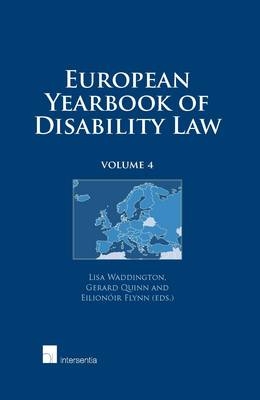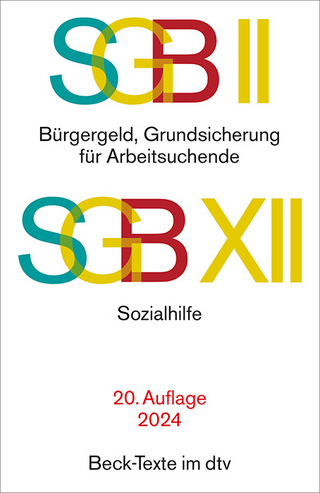
European Yearbook of Disability Law
Intersentia Ltd (Verlag)
978-1-78068-169-6 (ISBN)
ACKNOWLEDGMENTS EDITORIAL LISA WADDINGTON, GERARD QUINN and EILIONOIR FLYNN PART I: ARTICLES DISABILITY AND ACCESS TO JUSTICE IN THE EUROPEAN UNION: IMPLICATIONS OF THE UNITED NATIONS CONVENTION ON THE RIGHTS OF PERSONS WITH DISABILITIES EILIONOIR FLYNN and ANNA LAWSON 1. Introduction 2. Disabling Barriers in Accessing Justice 3. Conceptualizing Access to Justice 3.1. 'Access' and 'justice' 3.2. The Substantive Component 3.3. The Procedural Component 3.4. The Symbolic Component 4. The Development of a Right to Access Justice in International Human Rights Law 4.1. Origins of the Right to Access to Justice in International Human Rights Law 4.1.1. The Right to an Effective Remedy 4.1.2. The Right to a Fair Hearing 4.2. The Emergence of a Specific Right to 'Access to Justice' in the Convention on the Rights of Persons with Disabilities 4.3. Interconnections between Article 13 and other Convention Rights 4.3.1. Article 13 and Other Articles Affecting its Scope 4.3.2. Article 13 and Other Articles Operating to Achieve Access to Justice 4.4. Scope of Article 13 5. The Right to Access Justice in European Union Law 5.1. The EU and the CRPD 5.2. Access to Justice as a Fundamental Right in EU law 5.2.1. Scope of the Right 5.2.2. Effect of the Right 5.2.3. Non-Discriminatory Enjoyment of the Right 5.4. Access to Justice in the European Disability Strategy 2010 - 2020 6. Conclusion TRACKING THE PROGRESS OF THE PROPOSED WIPO TREATY ON EXCEPTIONS AND LIMITATIONS TO COPYRIGHT TO BENEFIT PERSONS WITH PRINT DISABILITIES ABIGAIL REKAS, JD 1. Introduction 2. The Right to Read 3. Accessible Formats 4. Copyright Law 5. The EU and InfoSoc Directive 6. EU Stakeholders' Platform 7. Timeline of the Right to Read for Print Disabled Persons 8. First Four Proposals 8.1. Proposal by Brazil, Ecuador and Paraguay, Relating to Limitations and Exceptions: Treaty Proposed by the World Blind Union 8.2. Draft WIPO Treaty on Exceptions and Limitations for the Persons with Disabilities, Educational and Research Institutions, Libraries and Archives (African Group) 8.3. Draft Joint Recommendation Concerning the Improved Access to Works Protected by Copyright for Persons with a Print Disability (European Union) 8.4. Draft Consensus Instrument (United States) 9. Towards Consensus 10. WIPO Stakeholders' Platform and TIGAR 11. Private Sector 12. Conclusions STAYING THE COURSE: THE EUROPEAN DISABILITY STRATEGY 2010 - 2020 DAVID L. HOSKING 1. Introduction 2. EU Disability Policy 3. The 2010 - 2020 Disability Strategy 3.1. Locating the Strategy 3.2. The 2010 - 2020 Strategy 3.3. The Implementation Plan 4. Resistance and Retreat? 4.1. Completing the Anti-discrimination Framework 4.2. A European Accessibility Act 5. A Critical Assessment of the 2010 - 2020 Strategy 6. Conclusion US AND EU PERPECTIVES ON GENETIC DISCRIMINATION IN EMPLOYMENT AND INSURANCE: STRIKING A BALANCE IN A BATTLEFIELD OF COMPETING RIGHTS AISLING DE PAOR 1. Introduction 1.1. The Background: Advances in Genetic Science 2. Ethical and Legal Dilemmas Arising from Third Party Use of Genetic Information 2.1. Genetic Discrimination 3. Genetic Discrimination in Employment - Exploring the Balance of Rights 3.1. The Desire for Healthy, Productive Workers 3.2. Genetic Testing to Advance Health and Safety 3.3. Consequences of Misuse of Genetic Information in Employment 3.4. Towards a Balance of Rights 4. Genetic Discrimination - A Fair (or Unfair) Practice in the Insurance Industry? 4.1. Arguments in Favour of Using Genetic Information: Perspectives from the Insurance Industry 4.2. Arguments Against Using Genetic Information: Perspectives from the Insured 4.2.1. The Social Purpose of Insurance 4.3. Insurer versus Insured 5. The Need for Regulation 6. The US Position - A Robust Approach to Genetic Discrimination?.. 6.1. Legislative History - The Trials and Tribulations 6.2. Legislative Position Prior to GINA - Limited Protections 6.3. The Arrival of GINA 6.3.1. GINA's Exceptions 6.4. Does GINA Live up to Expectations? 7. The Current European Position - A Patchwork of Laws 7.1. Legal Basis for Action - A Combined Non-Discrimination and Privacy Approach 7.1.1. Building a Case for EU-Level Regulation of Genetic Information 7.1.2. EU Charter of Fundamental Rights 7.1.3. Non-Discrimination in the EU 7.1.4. Protection of Privacy in the EU 7.2. Potential Obstacles to EU action 7.3. Current EU Secondary Law: Privacy and Non- Discrimination 7.3.1. Current Data Protection Law in the EU 7.3.2. Current Non-Discrimination Law in the EU 8. The UN Convention on the Rights of Persons with Disabilities - Can the Conclusion of the CRPD shape EU Regulation of Genetic Information? 8.1. EU Obligations under the CRPD 9. Conclusion - What Next for the EU? FLEXICURITY AND EMPLOYMENT OF PERSONS WITH DISABILITY IN EUROPE IN A CONTEMPORARY DISABILITY HUMAN RIGHTS PERSPECTIVE MARIA VENTEGODT LIISBERG 1. Introduction 2. The Contemporary Disability Human Rights Approach 2.1. Models of Disability and Equality 2.2. An Open, Inclusive and Accessible Labour Market 2.3. Anti-Discrimination Protection 2.4. Employment Promotion 2.5. The Involvement of Disability Organizations 2.6. Conclusion 3. Danish Flexicurity 3.1. An Open, Inclusive and Accessible Labour Market 3.2. Anti-Discrimination 3.3. Employment Promotion 3.4. Civil Society 4. Conclusion EQUAL TO THE TASK? RE-EXAMINING EU EQUALITY LAW IN LIGHT OF THE UNITED NATIONS CONVENTION ON THE RIGHTS OF PERSONS WITH DISABILITIES LISA WADDINGTON 1. Introduction 2. The Status of the CRPD under EU law 3. The CRPD, the Social Model of Disability and the Principles of Non-Discrimination and Equality 4. EU Disability Non-Discrimination and Equality Law 4.1. General Overview 4.2. The Employment Equality Directive 4.2.1. Definition of Discrimination 4.2.2. Reasonable Accommodation 4.2.3. Case Law of the European Court of Justice Interpreting the Personal Scope of the Disability Provisions of the Employment Equality Directive 5. Possible Tensions Between the CRPD and EU Non-Discrimination and Equality Law 5.1. Prohibition of Discrimination - Direct and Indirect Discrimination 5.2. Reasonable Accommodation 5.3. The definition of Disability 5.4. Protection from Discrimination on the Grounds of Disability for People who Associate with a Person with a Disability 5.5. Material Scope of the Protection from Discrimination 6. Conclusion PART II: ANNUAL REVIEW OF EUROPEAN LAW AND POLICY THE EUROPEAN UNION 1. Background to the European Union and Disability 1.1. Strategic Direction 1.1.1. Previous Strategies 1.1.2. Current Strategy: The European Disability Strategy 2010 - 2020: A Renewed Commitment to a Barrier-Free Europe 1.1.2.1. Implementation of the Strategy 1.1.3. Europe 2020: A Strategy for Smart, Sustainable and Inclusive Growth 1.2. Legislative Measures 1.2.1. Council Directive 2000/78/EC of 27 November 2000 establishing a general framework for equal treatment in employment and occupation 1.2.2. Proposal for a Council Directive on implementing the principle of equal treatment between persons irrespective of religion or belief, disability, age or sexual orientation (2008) 1.2.3. The European Accessibility Act 1.2.4. EU Structural Funds 1.3. The EU and International Legal Developments 1.3.1. European Union Conclusion of the UN CRPD 1.3.2. European Union Implementation of the UN CRPD 1.3.3. The Framework to Promote, Protect and Monitor the Implementation of the UN CRPD 1.3.4. Other Developments 1.4. EU Accession to the European Convention on Human Rights 1.4.1. Negotiation of the EU Accession 2. Activities of the European Commission 2.1. Directorate General for Justice 2.1.1. Unit for the Rights of Persons with Disabilities 2.1.2. Equal Treatment Legislation Unit 2.1.3. Non-discrimination Policies and Roma Co-ordination Unit 2.1.4. Other Activities 2.2. Directorate General for Health and Consumers 2.3. Directorate General for Competition 2.4. Directorate General for Internal Market and Services 2.5. Directorate General for Mobility and Transport 2.6. Directorate General for Enterprise and Industry 2.7. Eurostat 2.8. The Information Society and Media Directorate General 2.9. Directorate General for Employment, Social Affairs and Inclusion 2.10. Research and Innovation Directorate General 2.11. Directorate General Education and Culture 2.12. Directorate General for Regional Policy 3. Activities of the Council of the European Union 3.1. Activities under the Open Method of Coordination 3.1.1. Open Method of Coordination - Social Protection and Social Inclusion 3.1.2. Open Method of Coordination - European Employment Strategy 3.2. EU Presidency and Ministerial Conferences on Disability 4. Current Activities of the European Parliament 4.1. Activities of the Disability Intergroup of the European Parliament 5. Case Law of the Court of Justice of the European Union 5.1. The Powers of the Court of Justice of the European Union 5.2. Recently Decided Cases 5.2.1. Social Security 5.2.1.1. Juan Perez Garcia, Jose Arias Neira, Fernando Barrera Castro, Dolores Verdun Espinosa v. Familienkasse Nurnberg 5.2.1.2. Salemink v. Raad van bestuur het Uitvoeringsinstituut werknemers- verzekeringen 5.2.2. Cross-Border Healthcare 5.2.2.1. European Commission v. Portuguese Republic 5.2.3. Annual Paid Leave 5.2.3.1. KHS AG v. Winfried Schulte 5.2.3.2. Maribel Dominguez v. Centre informatique du Centre Ouest Atlantique and Prefet de la region Centre 5.2.4. Discrimination on the Ground of Age 5.2.4.1. Sabine Hennigs v. Eisenbahn-Bundesamt and Land Berlin v Alexander Mai 5.2.4.2. Reinhard Prigge, Michael Fromm, Volker Lambach v. Deutsche Lufthansa AG 5.2.4.3. Galina Meister v. Speech Design Carrier Systems GmbH 5.2.5. Jurisdiction and Enforcement of Judgments 5.2.5.1. Health Service Executive v. S.C. and A.C. 5.3. Cases Pending 5.3.1. Johann Odar v. Baxter Deutschland GmbH 5.3.2. K. v. Bundesasylamt 5.3.3. European Commission v. Italian Republic 5.3.4. HK Danmark, acting on behalf of Lone Skouboe Werge v. Pro Display A/S and Jette Ring v. Dansk almennyttigt Boligselskab DAB 6. European Economic and Social Committee 6.1. 2011 Opinions with a Disability Dimension 7. Activities of the European Union Fundamental Rights Agency 8. Studies and Reports 8.1. Study on Long-Term Care 8.2. Report on Persons Placed in Institutions 8.3. Getting a Life: Living Independently and Being Included in the Community 8.4. The European Union and the Right to Community Living - Structural Funds and the European Union's Obligations under the Convention on the Rights of Persons with Disabilities 8.5. The Family Dimension of the United Nations Convention on the Rights of Persons with Disabilities 8.6. Report of the Social Protection Committee 8.7. 5HSRUW RQ WKH &RRUGLQDWLRQ RI /RQJ-WHUP &DUH %HQH'WV 8.8. World Report on Disability 8.9. Reports Published by the Academic Network of European Disability Experts (ANED) 8.10. ICTs in Education for People with Disabilities Review 8.11. Making Television Accessible Report 8.12. Making Mobile Phones and Services Accessible for Persons with Disabilities Report 8.13. Best Practice Guidelines for Accessible Publishing 8.14. Web Accessibility Policy Making: An International Perspective 9. Disability Awareness Events 9.1. European Day of Persons with Disabilities 2011 9.2. Access City Award 9.3. Vodafone Foundation Smart Accessibility Awards THE COUNCIL OF EUROPE 1. Background to the Council of Europe and Disability 1.1. The Role and Institutions of the Council of Europe 1.2. The Strategic Direction of the Council of Europe on Disability 2. The European Court of Human Rights and Recent Case Law on Disability 2.1. The Convention and the Court 2.2. Background, Proceedings and Jurisdiction of the Court 2.3. Court Reform 2.3.1. Reform of the Court 2.3.2. EU Accession 2.4. Disability and the Court 2.5. Recently Decided Disability-Related Case Law 2.5.1. General Disability-Related Case Law 2.5.1.1. Stanev v. Bulgaria 2.5.1.2. D.D. v. Lithuania 2.5.1.3. M.S. v. the United Kingdom 2.5.2. Case Law Concerning Conditions of Detention for People with Disabilities 2.5.2.1. Arutyunyan v. Russia 2.5.3. Cases Involving Family Rights 2.5.3.1. Assuncao Chaves v. Portugal 2.5.4. Interesting Pending Applications 2.5.4.1. Djordjevic and Djordjevic v. Croatia 2.5.4.2. Malacu and others v. Romania 2.5.4.3. Gauer v. France 2.5.4.4. R.P. v. UK 2.5.4.5. Ryabov v. Russia 3. European Social Charter 3.1. Background of the European Social Charter and Committee 3.2. Recent Conclusions of the European Committee of Social Rights on State Party Reports on Disability 3.3. Recent decisions of the European Committee of Social Rights in Collective Complaints that Relate to Disability 3.3.1. International Federation of Human Rights (FIDH) v. Belgium 4. European Committee for the Prevention of Torture and Inhuman or Degrading Treatment or Punishment (CPT) 4.1. Background of the CPT 4.2. The CPT Standards and Disability 4.3. The 2011 CPT General Report 4.4. Country visits of the CPT and Disability 4.4.1. CPT visit to Ukraine (2009) 4.4.2. CPT visit to Poland (2009) 4.4.3. CPT visit to Latvia (2009) 4.4.4. CPT visit to Albania (2010) 4.4.5. Visit to Armenia (2010) 4.4.6. CPT visit to Kosovo (2010) 4.4.7. CPT visit to Romania (2010) 4.4.8. CPT visit to Macedonia (2010) 4.4.9. CPT visit to Bulgaria (2010) 4.4.10. CPT visit to Germany (2010) 4.4.11. CPT visit to Greece (2011) 4.4.12. CPT visit to Norway (2011) 4.4.13. CPT visit to Moldova (2011) 5. The Council of Europe Human Rights Commissioner 5.1. Background 5.2. Recent Activities of the Human Rights Commissioner on Disability 5.2.1. Annual Activity Report 2011 5.2.2. Position Papers and Speeches 5.2.2.1. 'Who Gets to Decide? Right to Legal Capacity for Persons with Intellectual and Psychosocial Disabilities' 5.2.2.2. 'The Right of People with Disabilities to Live Independently and Be Included in the Community' 5.3. Country Visits 5.3.1. Report on Visit to Italy 5.3.2. Report on Visit to Ireland 5.3.3. Report on Visit to Serbia 5.3.4. Report on Visit to Slovakia 5.3.5. Letter to the Prime Minister of the Republic of Moldova 5.3.6. Letter to the Minister for Foreign Affairs of Bulgaria 5.3.7. Letter to the Head of the Federal Department of Foreign Affairs of Switzerland 5.3.8. Interventions and Hearings 6. The Parliamentary Assembly and the Committee of Ministers 6.1. Recent Activities of the Parliamentry Assembly on Disability 6.1.1. Resolution 1843 (2011) and Recommendation 1984 (2011): The Protection of Privacy and Personal Data on the Internet and Online Media 6.1.2. Resolution 1845 (2011): Fundamental Rights and Responsibilities 6.1.3. Recommendation 1990 (2012): The Right of Everyone to Take Part in Cultural Life 6.1.4. Resolution 1859 (2012) and Recommendation 1993 (2012): Protecting Human Rights and Dignity by Taking into Account Previously Expressed Wishes of Patients 6.2. Recent Activities of the Committee of Ministers on Disability 6.2.1. Recommendation CM/Rec(2011)14 of the Committee of Ministers to Member States on the Participation of Persons with Disabilities in Political and Public Life 6.2.2. Building a Europe for and with Children Programme 6.2.3. Guidelines on Child-Friendly Health Care 6.2.4. Recommendation CM/Rec(2011)12 of the Committee of Ministers to Member States on Children's Rights and Social Services Friendly to Children and Families 6.2.5. Recommendation CM/Rec(2012)2 of the Committee of Ministers to Member States on the Participation of Children and Young People under the Age of 18 7. European Co-ordination Forum for the Council of Europe Disability Action Plan (CAHPAH) 8. The European Commission of Democracy Through Law (the Venice Commission) 8.1. Other Activities 8.1.1. Joint Opinion on the Draft Election Code of Georgia 8.1.2. Opinion on the Draft Law on Judges and Prosecutors of Turkey OTHER EUROPEAN INTERGOVERNMENTAL ORGANIZATIONS AND CIVIL SOCIETY GROUPS 1. European Intergovernmental Organizations 1.1. Organization for Economic Co-operation and Development (OECD) 1.2. :RUOG +HDOWK 2UJDQL]DWLRQ +- 5HJLRQDO 2I'FH IRU (XURSH ... 1.3. International Labour Organization 1.3.1. ILO Regional Office for Europe and Central Asia 1.3.2. The ILO Office for the European Union and the Benelux 1.4. World Bank 1.4.1. The World Bank and Disability 1.4.2. Europe and Central Asia Region 1.4.3. The World Bank and the European Union 2. European Civil Society Organizations 2.1. The European Disability Forum 2.1.1. General Activities 2.1.2. Papers/Reports/Publications 2.1.3. Commission Activities 2.1.4. European Parliament 2.2. Inclusion Europe 2.3. European Network on Independent Living (ENIL) 2.4. Mental Disability Advocacy Center (MDAC) 2.4.1. Legislative Reform 2.5. Mental Health Europe (MHE) 2.6. INTERIGHTS 2.6.1. Strategic Litigation 2.6.2. Publications PART III: LITERATURE REVIEW LITERATURE REVIEW PART IV: ANNEX OF KEY DOCUMENTATION Commission Staff Working Document Interpretative Guidelines on the Application of Regulation (EC) No 1107/2006 of the European Parliament and of the Council of 5 July 2006 concerning the rights of disabled persons and persons with reduced mobility when travelling by air Choice and Control: The Right to Independent Living Report of the European Union Agency for Fundamental Rights on the experiences of persons with intellectual disabilities and persons with mental health problems in nine EU Member States Extract from the Judgment of the European Court of Human Rights (First Section) of 24 July 2012 in the Case of Dordevic v. Croatia .
| Erscheint lt. Verlag | 2.7.2013 |
|---|---|
| Reihe/Serie | European Yearbook of Disability Law |
| Verlagsort | Cambridge |
| Sprache | englisch |
| Maße | 165 x 246 mm |
| Gewicht | 700 g |
| Themenwelt | Schulbuch / Wörterbuch ► Lexikon / Chroniken |
| Recht / Steuern ► Arbeits- / Sozialrecht ► Sozialrecht | |
| Recht / Steuern ► EU / Internationales Recht | |
| ISBN-10 | 1-78068-169-0 / 1780681690 |
| ISBN-13 | 978-1-78068-169-6 / 9781780681696 |
| Zustand | Neuware |
| Haben Sie eine Frage zum Produkt? |
aus dem Bereich


